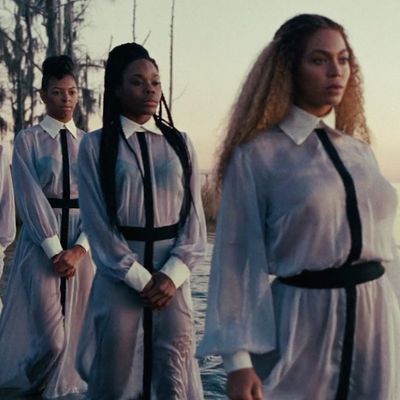
You could spend days unpacking the osmium-dense symbology of Lemonade, the new “visual album” by Beyoncé that aired on HBO Sunday. But look past each individual element — fire! hair! the color red! — and what you find is much greater than the typical peacocking of a music video, or splendor for splendor’s sake. Far from just providing accompaniment to her album, Lemonade as a movie is a complete, consistent, and impeccably well-designed piece of art on its own, with a mission that both illustrates and enhances the themes of her music. Only two months after stealing the Super Bowl, Beyoncé has made a Terrence Malick-esque tone poem that aims to reappropriate the legacy of the black woman within the American narrative through a truly remarkable piece of filmmaking.
Because whatever Lemonade is — visual album, music video, a costume designer’s wet dream — it’s also a film, and it shares with Malick — the revered director behind Badlands, The Tree of Life, and more — a penchant for whirling, choreographed cinematography as well as an interest in nature as a place from which people emerged and to which they can return. Shot like an art film, Lemonade’s camera moves constantly, often in the service of mood over clarity; Beyoncé utilizes Steadicam and handheld photography to establish a palette, and its many, many, many settings mean that the fluidity and liquid chaos of its visual style tends to be the main touchstone across the otherwise different capsule videos that comprise the whole.
Unlike your typical music video, though, the point of all this isn’t just to showcase a musician or sell Beats headphones; it’s to create an allegory. The musician as visual artist is hardly a new phenomenon, but Beyoncé’s auteurism here — marshaling a corps that includes six other directors, multiple DPs, and a sizable crew in addition to the army that helped her make the music — dovetails with the substance of her particular vision. Lemonade puts a distinctly black-female imprint on the Wild West of the American creative soul, filling its canvas with black women whose bodies and faces are treated as subjects, not objects.
Beyoncé’s camera — and again, it would be inaccurate to treat this as anything other than Beyoncé’s camera — functions as the porthole through which we, the viewer, both see and are seen by the artist, who rarely takes her eyes from its lens. We are being forced to consider an antebellum South made up solely of black women; a New Orleans comprised mainly of black women; a suburbs of black women; an urban environment in which a black woman takes a baseball bat to that most masculine of machines, the muscle car. We are given a portrait of black women as nature, God, and the moon; men are a corruption, an interference, and when they appear it’s often as antagonists or jesters. There are no white people in this world that Beyoncé’s made, but not because they’ve been cast out or eradicated. They’re just not there.
What results is a sort of bifurcated contemplation, the utopian dream of women living in nature, with their daughters, split by the history of violence that has prevented them from doing so — whether it’s enslavement, here present through its pointed erasure; the emotional violence of infidelity and abuse; or the cultural bias of discrimination, misogyny, and maltreatment. By the end, Beyoncé appears to arrive at a place of hope, reunited with her husband (you may have heard of him) and her daughter, frolicking on the field of the Superdome like American royalty. (The aesthetic of the ruling class is another favorite symbol: think of Beyoncé’s Nefertiti costume, or the throne she occupies while Serena Williams — another culturally dominant black woman — moves nearby.)
But on the way there, she depicts tragedy, suffering, and anger, and not only in the form of those pretty section titles (another similarity with Malick, specifically his latest movie Knight of Cups): She shows the black mothers of Trayvon Martin, Eric Garner, and Michael Brown holding pictures of their black sons, who were killed by white cops. Of course, this is an expression of support for these victims and their families, and the many other victims just like them, but by locating it within her reappropriated South, it’s also a statement of intent. By editing and redressing the iconography of our nation’s history — a privilege normally reserved for white men — Beyoncé asserts her power and that of black women as a collective.
On the most surface of surfaces, Lemonade is a dope music video. More than that, though, it shows an entertainer operating at a level as high as any other currently working in the mainstream, and doing so with remarkable precision. Possibly it’s because she’s a woman, and she knows she must be flawless to be taken seriously; possibly it’s because she’s a perfectionist, or a completist or a mogul or a savant. But compare this release to Kanye West’s glorious, psychotic Life of Pablo rollout: Where Kanye experimented and improvised, Lemonade came out fully formed. If there were any holdouts on the subject of whether Beyoncé had ascended from popular musician to a significant social and political artist, a comprehensively fluent commentator on the culture in which she exists, Lemonade should destroy them. This is bravura performance, a truly interesting and innovative piece of filmmaking that presents a provocative revision of our country.
The album ain’t bad, either.

